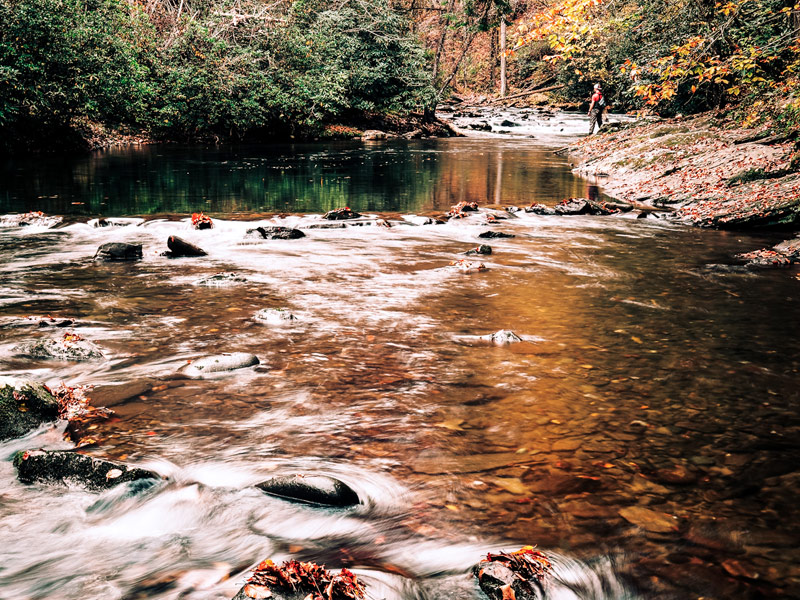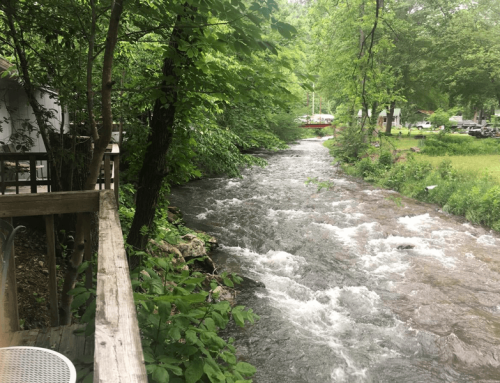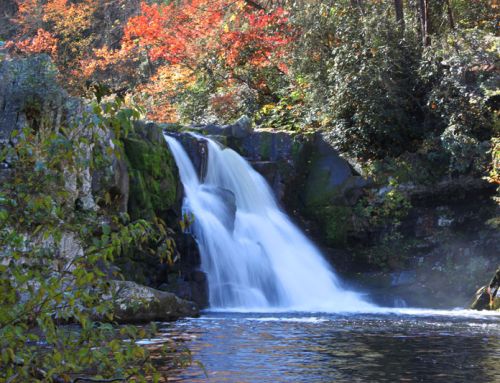Just imagine it: a mountain stream rippling through the forest. You step into the soothing rush as the wind softly whispers through the trees. You find the rhythm of the cast and let the line fly through the air. The lure glances against the water’s surface with a light splash, and you feel the freedom that only an angler knows.
That’s what it’s like to fish in the Great Smoky Mountains. Here, you’ll find a first-rate destination with a diversity and class of wild trout that draws fly fisherman – both beginners and pros – from all over the world. Packed with over 200 trout streams that combine into more than 700 miles of breathtaking fishing spots, these gorgeous mountains make the perfect backdrop for catching trout that’s as varied as the landscape.
Because fly fishing is allowed year-round in the Smokies, there’s always a great catch just waiting for you. All you have to do is pick the season and your ideal fishing conditions, then your escape awaits. If you’re searching for solace, hike to a remote headwater stream, or if you want a breezy and refreshing morning teaching the kids how to cast a line, then choose from plenty of easy-to-access roadside spots. Keep reading to learn more about some of our favorite places to go fly fishing in the Smoky Mountains.
Where to Fly Fish for Trout in the Smokies
-
Little River
You’ll find one of the most popular trout fishing spots in the Smoky Mountains on the main section of the Little river. This area flows all the way from the cascading Sinks area inside the Great Smoky Mountains National Park down to Townsend, TN. The whole route is easily accessible by road, so you can pick from a wide-ranging area. Choose from waterfalls, deep pools, or expansive glassy stretches bordered by towering evergreen trees. You’ll find brown, rainbow, and brook trout in this section, but depending on the time of year, you may find a lot of other people too. This area can get a little crowded. So, a mid-week fishing trip or a late-winter/early spring visit might be the best time to go if you’re hoping for some solitude.
-
Middle Prong Little Pigeon River
If you’re hoping to escape from the crowds, then the Middle Prong section of Little Pigeon River is an ideal full-day fishing excursion. Located in the Northwest section of the Great Smoky Mountains National Park, you can hike into this small gorge, but be warned. It’s not for the faint of heart. The terrain is fairly challenging, and you’ll often see (or more likely hear) rattlesnakes sunning themselves on nearby boulders. Pack a lunch and spend the whole day casting your line for stunning rainbow trout. (P.S. Because it’s a bit remote, make sure to let someone know where you’re going.)
-
Cataloochee Creek
Over on the East side of the park, you’ll find Cataloochee Creek, which is really more of a small river than a creek. Head to the lower sections of the creek where you’ll enjoy wide, roomy areas to cast your line for brown trout. Bonus – there’s a good chance you’ll see some wild elk here. In 2001, the Great Smoky Mountains National Park re-introduced an elk herd in the valley, and the Cataloochee area is a prime elk watching spot. Read More
-
Raven Fork (Upper Raven Fork/Three Forks/Enloe Creek)
Right along the border between the Great Smoky Mountains National Park and the Cherokee Reservation, you’ll find a remote and stunningly rugged landscape in The Gorges of Raven Fork. It’s ill-advised to take on this hike alone, as it can be a little dangerous, but if you head upstream of The Gorges, you’ll find a refreshing and secluded place with deep pools where brook and rainbow trout snap for flies on the regular. Bring your camping gear along and make it a weekend trip.
-
Deep Creek
Just minutes away from Bryson City, NC is Deep Creek, one of the top fly fishing destinations in the Smokies. You’ll find native brook trout and browns that are hungry for dry flies and streamers. Evening fly fishing is prime time here, especially when the hatch is on. When you’re not casting a line in the water, venture into Bryson City – just a 15-minute drive away – and take a tour of the Southern Appalachian Museum of Fly Fishing. Then grab a craft beer and dinner as you tell tales of the big one you caught earlier.
-
Fontana Lake
Don’t leave the Bryson City area before stopping by Fontana Lake. It’s the perfect spot for fly or rod fishing, especially if you’d rather get out of the water and fish from a boat. Surrounded by beautiful, wooded hills, the lake is a peaceful and relaxing destination to hide away for the weekend. This otherworldly lake is home to rainbow and brown trout, as well as other species like smallmouth bass and panfish, who love a good popper fly.
Do I need a Fishing License to Fish in the Great Smoky Mountains National Park?
Fishing in the Great Smoky Mountains National Park requires a valid fishing permit or license from either Tennessee or North Carolina for anyone 16 year of age or older. You can get either a resident or non-resident license for 10 days or one year. There are limits and restrictions on the number and size of fish you an catch, and even the types of lures you’re allowed to use. (For example, only artificial flies or lures with a single hook are allowed, but you can fish with two single hook flies on a line.) Just be sure to do your research before you go, and you’ll be ready for an amazing fly fishing adventure in the Smokies!




